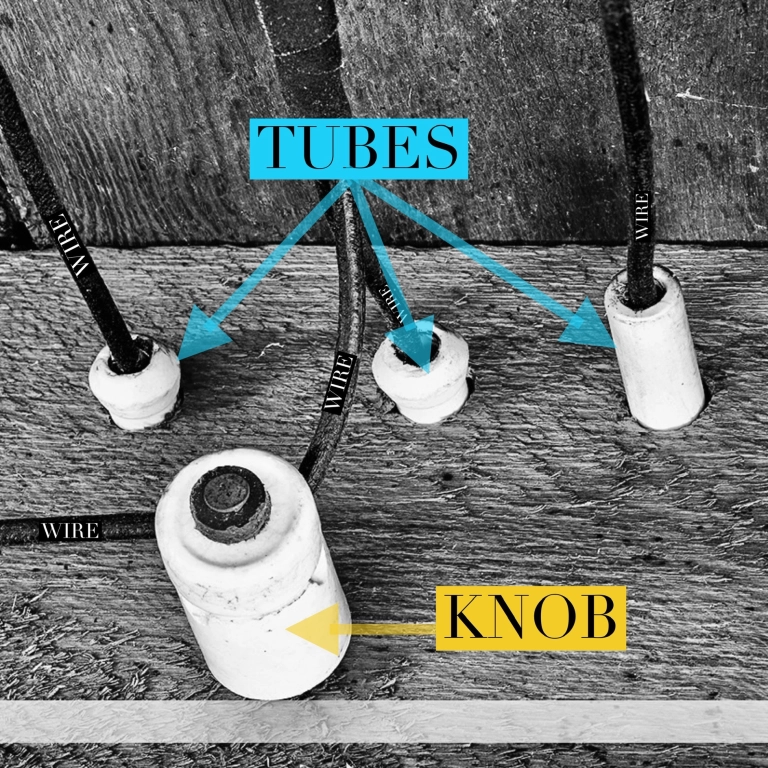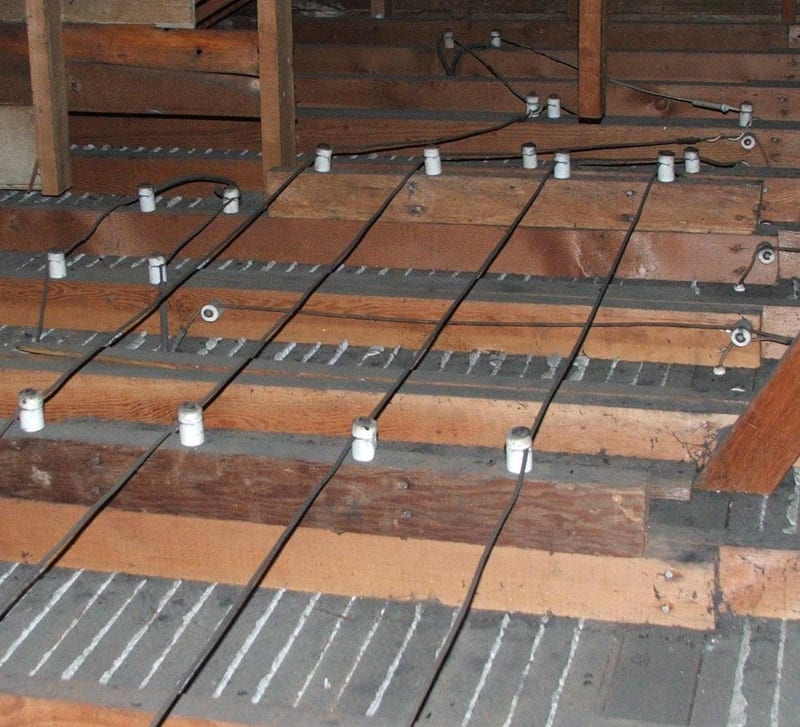4.9 1890+ Google Reviews

Knob and tube wiring is an old wiring type found in older homes. Installed from the 1880s until the 1940s, most of it is over 100 years old at this point. Insurance companies, home inspectors, and electricians often describe it as a fire hazard. But is knob and tube wiring really dangerous?
Modern wiring consists of at least one hot wire, one neutral wire, and a ground wire inside a PVC sheathing or metal armor. Each wire is color coded and individually insulated with a PVC jacket.
However, the most notable differences in a knob and tube system are that there is no ground wire, and the wires are not contained in a jacket or conduit. Each wire of a knob and tube wiring system is insulated with rubber insulation. However, the hot and neutral wires run separately through wall and ceiling cavities instead of together in a sheathing. Porcelain knobs support the wires to keep them off the structure, and the wires pass studs and joists through ceramic tubes.
The primary purpose of the knobs and tubes is to protect combustible materials from directly touching live wires.

Although there are better alternatives today, knob and tube has it’s advantages.
K&T wiring can handle higher amperage than the same size similar wire. Since the wires are separate from each other and the structure, they cool more efficiently. Since heat is a limiting factor in electrical capability, this gives knob and tube the advantage.
Whereas modern wiring is secured to wood framing, knob and tube was suspended away from framing. This makes it much less likely that someone will puncture a wire with a nail or screw.
The porcelain knobs and tubs last virtually forever. Plus, this wiring was installed by highly qualified professional electricians. It was a specialized skill during that era leading to quality installations.
Although organizations such as the NFPA (National Fire Protection Association) and CPSC (Consumer Product Safety Commission) track residential fires, there are no statistics specific to knob and tube wiring.
Unlike aluminum wiring, which studies show is 55 times more likely to have conditions prone to fire, no such data exists for knob and tube wiring.
Plus, most of the information regarding knob and tube as a fire risk or safety hazard is presented and perpetuated by electricians. Ultimately, electricians have much to gain by spreading hyperbolic language about this type of wiring.
So, with little information available, is knob and tube wiring really dangerous?
The only study ever done on knob and tube wiring concluded that knob and tube is not inherently dangerous. However, some factors make k&t wiring less safe and more prone to electrical fires.
Most electricians and home inspectors state that the rubberized cloth deteriorates over time. However, a study showed that almost all insulation deterioration occurred at light fixtures. Ultimately, light bulbs generating excessive heat for decades deteriorate the insulation.
Possibly the main problem with knob and tube wiring is that there is no ground wire. This obsolete wiring method is a shock hazard.
As stated in How to Upgrade 2 Prong Outlets, the ground wire
” bonds all-metal non-current-carrying components to the main panel.
In ground faults, this wire carries the flow of electricity back to the main panel. Accordingly, this allows the circuit breaker to trip.”
Without a ground wire, non-current-carrying metal components, such as the metal frame of an appliance, will stay live until grounded. So if a homeowner touches the frame and is grounded, the electricity will flow through them, also known as an electrical shock.”
However, no ground wire is not a characteristic limited to knob and tube wiring. Despite the wiring type, many older houses do not have ground wires. Plus, being an old, less safe ungrounded system is not the same as being a fire or safety hazard.
Although knob and tube is not inherently dangerous, homeowners can make everything worse. Knob-and-tube’s most significant risk of fire is caused by subpar electrical work. In other words, most of the improper and loose connections, open splices, and over-fusing are caused by homeowners.
These older systems have fewer electrical outlets and lights. Plus, homes built with knob-and-tube likely did not have laundry rooms, air conditioners, or other modern appliances. Even the outlets that were installed were older two-pronged outlets.
So, homeowner’s building additions, adding circuits, bootlegging grounds, and upgrading this old system themselves, account for nearly all the conditions that lead to fires. Unfortunately, a lot of these improper modifications are hidden behind drywall and plaster. A home inspection or electrical inspection may not find visible defects, but there could be hidden defects.
In 1987, the national electrical code prohibited insulation installed over knob and tube live wires. The idea is that this form of electrical wiring relies on the free air space around it to dissipate heat. Installing insulation over it traps the heat and causes a fire. However, there is little evidence that this actually occurs.
Regardless, it’s against the building code to install insulation over it. Article 394.12 of the National Electrical Code (NEC) 2002 Handbook states:
“Concealed knob-and-tube wiring is designed for use in hollow spaces of walls, ceilings, and attics and utilizes the free air in such spaces for heat dissipation. Weatherization of hollow spaces by blown-in, foamed-in, or rolled insulation prevents the dissipation of heat into the free air space. This will result in higher conductor temperature, which could cause insulation breakdown and possible ignition of the insulation.
So, if you want to insulate your older home that has knob and tube, you will need to upgrade to modern wiring first.
Find out from the home inspector that the home you’re buying has knob and tube can be intimidating. Keep in mind that knob and tube wiring is not inherently dangerous. Ask your home inspector if there were any visible issues with it. If the inspector sees serious problems, there are likely more problems that they can’t see.
Many insurance companies will not issue a homeowners insurance policy if there is active knob and tube. Although there are a few that will issue a policy, it is much more expensive. And others require a full electrical inspection by a qualified electrician before issuing a policy.
It isn’t usually a deal breaker but is something to consider when buying an older home.
Knob and tube wiring was wired with 2-prong outlets. Although 2-prong outlets are still up to code, they limit what modern appliances and devices you can use. Take comfort in knowing that upgrading 2-prong outlets is not that difficult.
The industry standard is adding GFCI protection to any circuits you want to add three-prong receptacles to. That’s it.
The biggest takeaway is to not jump to conclusions when it comes to knob and tube wiring. Although it has the “greatest potential for abuse”, there is nothing inherently dangerous about knob and tube wiring. Again, there may be defects with the wiring making it dangerous at those specific locations. There are many reasons to consider upgrading it, but not simply because it’s dangerous. Because it’s not.